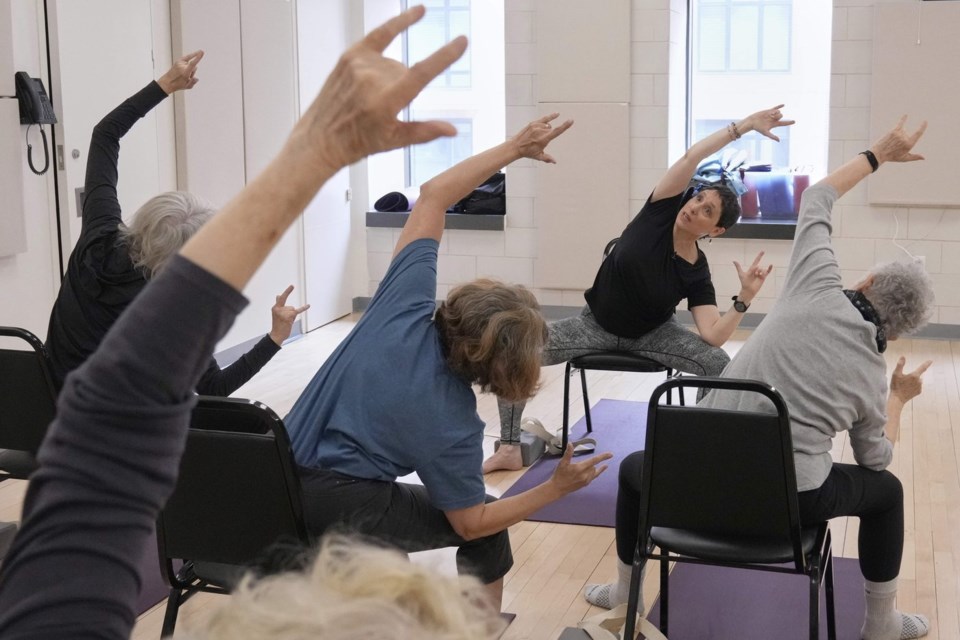WASHINGTON (AP) — Chair yoga modifies traditional yoga poses to suit older adults and those with physical limitations. But as AP Lifestyles Writer Leanne Italie explains, that doesn’t mean it’s any less of a workout. As older adults embrace active lifestyles, chair yoga has surged in popularity.
In this episode of “The Story Behind the AP Story,” Italie explains the origins of chair yoga, its benefits and how it works.
Haya Panjwani, host: Hi, I’m Haya Panjwani, and I’m the host of “The Story Behind the AP Story.” Today we’re joined by Leanne Italie, a lifestyles reporter for The Associated Press. Hi, Leanne. How are you doing?
Leanne Italie, AP lifestyles reporter: I'm great. How are you?
PANJWANI: I’m great. Thank you for asking. Today we’re going to talk about chair yoga. What is it?
ITALIE: Yeah, sure, so chair yoga has a really sort of interesting and important history. Traditional yoga done on the floor on mats is over 5,000 years old, but chair yoga is a relatively new offshoot.
In 1982, a yoga instructor named Lakshmi Voelker noticed that a student of hers in a traditional yoga class who was in her 30s and suffered from arthritis was having trouble getting down on the floor. So, Voelker decided to adapt some poses for use in a chair. And she has since sort of become the guru of chair yoga, and she has written, since co-written a book about it.
Chair yoga has really gone a long way in boosting the accessibility of yoga itself to many age groups, including older people and people who have physical limitations.
PANJWANI: Are there any communities that benefit from chair yoga in particular?
ITALIE: Absolutely. I mean, chair yoga is great for anybody who wants a gentle workout, but it’s not easy, and there are many, many benefits. So, obviously, it has a lot to offer older people, particularly older women who are prone to osteoporosis, and it’s a gentle and safe way to improve your flexibility, your strength and your balance. It helps minimize the risk of falls and fractures.
There’s not a body part that it really doesn’t help. It helps the spine, the hips, the legs, all engaged. It also helps your core, helps you strengthen your core and your back, and it can help manage stiffness and pain associated with a lot of conditions, including arthritis and osteoporosis. It’s not difficult to adapt traditional yoga poses for a chair, which I found kind of surprising, because, you know, yoga looks so daunting sometimes, and there are so many — there’s a spiritual aspect to yoga that a lot of people don’t realize, you know, in the West. You know, in addition to all the physical benefits, you know, there are relaxation benefits there’s, you know, stress management benefits, like from the breathing and the mindfulness aspect of yoga. So, all of that can be adapted to a chair as well.
PANJWANI: How is chair yoga linked to better well-being or fall prevention?
ITALIE: Yeah, I mean, while there’s a lot of research on regular traditional yoga, there is some research that breaks out chair yoga in particular. One study from 2012 found that 15 minutes of chair yoga significantly improves physical and psychological markers for stress. And then another study in the April 2023 journal Healthcare indicates that chair yoga went a long way to counter knee osteoarthritis in women 65 and older. There are other benefits, too, like for instance, office workers who spend a lot of time hunched over screens can just do chair yoga right there in their chair at their desks, and that can really improve posture.
PANJWANI: Your story talks about the divide between men and women who do yoga. Why is that?
ITALIE: I find this really, really interesting, and in the story that we did on chair yoga, we asked some longtime yoga participants, practitioners, what they thought -- some women in their 70s and their 80s who’ve been doing yoga for 40, 50 years, why are there not more men in your classes? And they said, well, there’s no one definitive answer here, and there’s no way to avoid a massive generalization on who men are as a group. But, you know, so you do get different answers depending on who you ask. But, data from the U.S. Centers for Disease Control and Prevention do show that women are more than twice as likely as men to practice yoga.
You know, ancient yoga over the many thousands of years was exclusively reserved for men. And then it became popular in Western culture in the 1960s and ’70s as part of sort of the hippie counterculture movement and the New Age movement. And marketing started to skew to women in the ’80s and ’90s. And that sort of was an outgrowth of the growing fitness industry in the West and the rise of workouts like on VHS tapes and DVDs that people could do at home.
PANJWANI: Thank you for listening to “The Story Behind the AP Story.” To listen to previous episodes, visit apnews.com.
Haya Panjwani, The Associated Press



